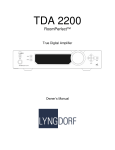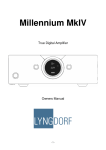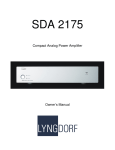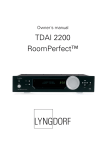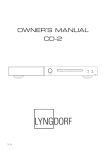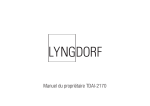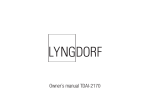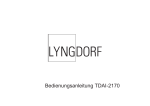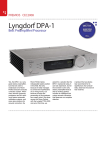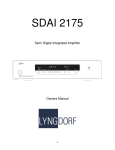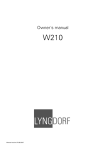Download Lyngdorf Audio CD-1 User's Manual
Transcript
CD-1 Compact Disc Player Owners Manual -1- Table of Contents WARNINGS.........................................................................................................................................3 Explanation of graphical symbols .....................................................................................................3 Important safety instructions.............................................................................................................4 Unpacking the CD-1 .............................................................................................................................4 Accessories ......................................................................................................................................5 Operating voltage .............................................................................................................................5 Product Registration .........................................................................................................................5 Introduction ..........................................................................................................................................6 Front panel............................................................................................................................................7 Front panel controls and functions ....................................................................................................7 Rear panel...........................................................................................................................................10 Remote Control...................................................................................................................................11 Main Display ......................................................................................................................................13 Menu System Display .........................................................................................................................15 Firmware ............................................................................................................................................17 Connectors..........................................................................................................................................17 Mains Connector ............................................................................................................................17 Analog outputs ...............................................................................................................................17 Digital outputs................................................................................................................................18 Cleaning and maintenance...................................................................................................................18 Technical specifications ......................................................................................................................19 Audio .............................................................................................................................................19 Protection .......................................................................................................................................19 Mains .............................................................................................................................................19 Mechanical.....................................................................................................................................20 Discs ..............................................................................................................................................20 Technical assistance............................................................................................................................21 Support ...............................................................................................................................................21 -2- WARNINGS CAUTION RISK OF ELECTRICAL SHOCK. DO NOT OPEN CAUTION: TO REDUCE THE RISK OF ELECTRICAL SHOCK, DO NOT REMOVE COVER. NO USER-SERVICEABLE PARTS INSIDE. REFER SERVICING TO QUALIFIED PERSONNEL. TO REDUCE RISK OF FIRE OR ELECTRIC SHOCK, DO NOT EXPOSE THIS APPLIANCE TO RAIN OR MOISTURE. Explanation of graphical symbols Exclamation symbol The exclamation point within an equilateral triangle is intended to alert the user to the presence of important operating and maintenance (servicing) instructions in the literature accompanying the product. Lightning symbol The lightning flash with arrowhead symbol within an equilateral triangle, is intended to alert the user to the presence of uninsulated “Dangerous Voltage” within the products’ enclosure that may be of sufficient magnitude to constitute a risk of electrical shock to persons. -3- Important safety instructions 1:Read these instructions. 2:Keep these instructions. 3:Heed all warnings. 4:Follow all instructions. 5:Do not use this apparatus near water. 6:Clean only with a dry cloth. 7:Do not block any ventilation openings. Install in accordance with the manufacturer’s instructions. 8:Do not install near any heat sources such as radiators, heat registers, stoves, or other apparatus that produce heat. 9:Do not defeat the safety purpose of the grounding-type plug. A polarized plug has two blades with one wider than the other. A grounding type plug has two blades and a third grounding prong. The wide blade or the third prong is provided for your safety. If the provided plug does not fit into your outlet, consult an electrician for replacement of the obsolete outlet. 10:Protect the power cord from being walked on or pinched particularly at plugs, convenience receptacles, and the point where they exit from the apparatus. 11:Only use attachments/accessories specified by the manufacturer. 12:Use only with cart, stand, tripod, bracket, or table specified by the manufacturer, or sold with the apparatus. When a cart is used, use caution when moving the cart/apparatus combination to avoid injury from tip-over. 13:Unplug this apparatus during lightning storms or when unused for long periods of time. 14:Refer all servicing to qualified service personnel. Servicing is required when the apparatus has been damaged in any way, such as when the power-supply cord or plug is damaged, liquid has been spilled or objects have fallen into the apparatus, the apparatus has been exposed to rain or moisture, does not operate normally or has been dropped. 15:Do not expose this apparatus to dripping or splashing and ensure that no objects filled with liquids, such as vases, are placed on the apparatus. 16:To completely disconnect this apparatus from the AC Mains, disconnect the power supply cord plug from the AC receptacle. 17:The mains plug of the power supply cord shall remain readily operable. 18:Do not expose batteries to excessive heat such as sunshine, fire or the like. 19:Do not connect any output from this Compact disc player to any other Compact disc player’s output or any other voltage source. Unpacking the CD-1 Carefully remove the unit and accessory kit from the carton, visually check for shipping damage. Contact both the shipper and Lyngdorf Audio immediately if the unit bears any sign of damage from mishandling. All Lyngdorf Audio equipment is carefully inspected before leaving our factory. KEEP SHIPPING CARTON AND PACKING MATERIALS for future use or in the unlikely event that the unit needs servicing. If this unit is shipped without the original packing, damage could occur and void the warranty. -4- Accessories You should find the following in the accessory kit: 1. 2. 3. 4. 5. One mains cord This manual Customer registration form Remote control RS232 Cable for firmware upgrade from a PC Operating voltage The CD-1 is selectable to one of the following power ratings: 100V-120V~ at 50-60Hz with a power rating of 20W 220V-240V~ at 50-60Hz with a power rating of 20W WARNING: Connect the power input only to the AC source printed on the label and the setting shown on the voltage selector switch. The warranty will not cover any damage caused by connecting to the wrong type of AC mains. The CD-1 has three power modes: 1. ON – The [power] button will turn the CD-1 on. The CD-1 will start up in standby mode. 2. STANDBY – The [standby] button will put the CD-1 in standby mode or bring the CD-1 back from standby mode. If standby mode is requested while the tray is open, the CD-1 will close the tray before entering standby mode. 3. OFF – After Power [off] or Standby, the settings of CD-1 are retained. If the CD-1 was in random mode and/or repeat-all mode, this mode will also be retained. Please note that some parts of the mains entry section still carry live mains. Product Registration Please record the serial number of your product here for future reference. The serial number is printed on the label on the CD-1 rear panel. You will need this serial number, should you ever require service for your CD-1 Compact disc player. CD-1 serial number: _____________________ Please fill out the enclosed customer registration form and submit it to Lyngdorf Audio so we can register you as owner of the unit and keep you informed of future upgrades of the product. -5- Introduction Lyngdorf CD-1 is an audio optimized upsampling Compact Disc Player with low jitter clock and a High Performance DAC section. Features: • Audio optimized CD transport mechanism with low jitter clock • Linear Low Noise power supply based on Holmgren Transformer technology. • 3 digital outputs: AES, SPDIF, Toslink - selectable sample rate 44.1/48/96/192 kHz. • Transformer coupled digital interconnects (eliminates ground loops). • High Performance DAC section operating at 96 kHz with sample rate conversion. • Stereo DAC output, balanced and unbalanced. • IR remote control. • Firmware upgradeable from PC. Performance: • Frequency response L/R, 20 – 20000 Hz: +/- 0.02 dB • Signal-to-noise ratio, A-wgt (“infinity zero” track): -115 dBA • Dynamic Range, A-wgt (output -60 dBFS 1kHz) -100 dBA • Distortion THD + N, 20 – 20000 Hz: 0.0018 % • Crosstalk, 125 – 16000 Hz: -114 dB • 0db analog output level: 3.8 Vrms • Unbalanced analog output impedance: 75 Ohm • Balanced analog output impedance: 100 Ohm -6- Front panel Fig 1: CD-1 front panel Front panel controls and functions The buttons/controls on the front panel of the CD-1 can all be used either by directly pressing them on the front panel or by operating the similar keys on the included remote control. All keys on the front panel except the Mains switch (1) can be found on the remote control. Additional buttons on the remote control include the following: random, repeat, A/B and the digits 0-9. Please note the left < and right > arrows in the center button area of the remote control work exactly like the Skip/Search buttons |<< / >>| on the front panel. The play/pause buttons and the Enter button also work in exactly the same way. (1) Mains switch Powers the CD-1 on/off. (2) Standby button Standby mode, this can also be selected on the remote control. (3) Eject The CD Loader Tray can be opened and closed using the eject button. If the button is pressed during play mode, the disc will be stopped before the tray is opened. (4) The CD Loader Tray While the tray is opened pressing play will cause the tray to close and start playback. Selecting a track with the digits on the remote control will also close the tray and start playback at the selected track. (5) Indicator light Power on indicator LED (6) Play / Pause Pressing the play/pause button or the skip wheel (11 & 12 see below instructions) will start playing the CD. Pressing the button again will toggle between play mode and pause mode. You can select a new track with the skip buttons, the skip wheel (11 & 12 see below instructions) or directly with digits during pause mode. This will cause the CD-1 to position -7- itself at the start of the selected track but it remains in pause mode until the play/pause button is pressed again. (7) Stop Pressing stop during play or pause mode will stop the CD. (8 & 9) Skip / Scan Pressing briefly on the Left |<< Skip/Scan button or turning the skip wheel left will restart the current track or, if currently playing within the first two seconds of the current track, skip to the previous track. Turning the skip wheel right or pressing shortly on the >>| button will skip to the next track. Skipping left from the first track will always restart this track while skipping right from the last track will have no effect - unless the CD-1 is in Repeat All mode. In this case, the CD1 will loop-around to the last / first track. Holding the |<< or >>| buttons down for more than half a second will start the CD searching (Scan) in the indicated direction. The CD starts at approximately twice the normal speed, but after a few seconds the speed will increase further. Searching (Scan) past the end of the disc or before the start of the disc will stop the disc playing, unless the CD-1 is in Repeat All mode. In this case, the disc will loop-around to the start or the end of the disc. (10) Menu functions In the menu there are several options for setting up the CD-1, press Menu to enter. In the main menu, the different menu items can be selected with the |<< and >>| keys or with the skip-wheel. Once the correct menu item has been found, pressing the play/pause button or the skip-wheel will enter the sub-menu. In the sub-menus the current value of the setting is shown. A new value can be selected using the |<< and >>| keys or the skip-wheel. To accept the change, press the play/pause button or the skip-wheel. Pressing the menu button again or selecting <Exit Menu> will exit the menu without saving changes. (11 & 12) Play/Select (also referred to as the Skip Wheel) The Play/Select button is a skip-wheel which allows you to Skip left |<< and Skip right >>| by turning the wheel in either direction. The button in the centre works in exactly the same way as the play/pause button. During play mode, it toggles between play and pause. In the menu mode the button is used as the select-function. A-B Repeat mode A-B Repeat mode is entered by pressing the [A/B] button on the remote once to mark the start time [A] then pressing it again to mark the end time [B]. Pressing the [A/B] button a third time will return the CD-1 to normal playing mode. Using other functions such as skip, scan or direct track selection from the remote control will also exit to normal playing mode. If the [A/B] button is pressed during Random mode and/or Repeat One mode, these modes will be cancelled. -8- A-B Repeat mode is indicated in the lower left-hand corner of the display. When [A] time has been set and CD-1 is waiting for [B] time, the symbol “A ” will be displayed. Once [B] time has been selected and the CD-1 is playing in A-B Repeat mode, the symbol will be changed to “AB”. Random Play mode When the ‘Random’ button is pressed on the remote control or Random mode is activated in the menu, the Random Play mode is entered and CD-1 creates a random play list. This starts playing from the list instead of playing the tracks in numeric order. If a track has already been selected or a track is playing, this track will automatically become the first in the random play list so no new track is selected by enabling Random Play mode. Using the number buttons on the remote control to select a specific track number, the Random Play mode will cause the CD-1 to create a new play list with the selected track as the first. The CD-1 will then start playing this track. Using the skip wheel (11 & 12) on the front panel or the Skip/Scan |<< / >>| buttons during Random Play mode will skip to the previous or next track in the random play list. The skip functions will not skip past the beginning or end of this play list unless Repeat All is selected, then the next and previous functions will loop around at the beginning or end of the play list. Selecting Repeat All during Random Play mode will repeat the random play list after the last track in the list. The play list is not affected. Selecting Repeat One during Random Play mode will repeat the current track playing without affecting the play list. If the Stop button is pressed during Random play mode, a new random play list will be generated when Play mode is entered again. Turning Random Play mode off and on again will cause the CD-1 to generate a new random play list. Repeat mode Selecting Repeat mode will allow the CD-1 to skip to the first track again when the end of the last track is reached. Repeat One mode Selecting Repeat One mode will allow the CD-1 to restart playing the track when the end of that track is reached. -9- Rear panel Fig 2: CD-1 rear panel. (1 & 2) Analog output right and left RCA Connectors (3 & 4) Analog balanced output right and left XLR Connectors for balanced output (5) Optical output Toslink Connector for digital output (6) AES Output XLR Connector for AES output (7) SPDIF SPDIF output (8) RS232 INPUT/AUX AUX and INPUT RJ45 connectors The RS232 communication connectors are for communication to a PC or remote control from Lyngdorf equipment with broadcast commands or linked control between other components. The Input is looped to Aux for daisy chaining of components. The “INPUT” is used for connection to a PC/computer to upgrade the firmware. (9) MAINS INPUT IEC320 type connector (10) POWER MODE SELECTION SWITCH The CD-1 has a large switch above the MAINS INPUT (9) selected to the correct voltage for your location or Country’s power supply. This switch is selected to either 115V or 230V operation. WARNING: Always check the correct voltage 115V or 230V operation has been selected for the voltage in your location or country. Failure to do this may result in serious damage to your CD-1 component. - 10 - Remote Control The remote control is used to access the menu system and replicate the buttons directly accessible on the front panel. The four buttons used for selecting which device to control are described below. To control the CD player the CD key should be pressed, please note the volume and mute buttons will still work with a Lyngdorf Amplifier, even in CD mode. • Amp – Selects the remote for operation with a Lyngdorf Amplifier. • RCS – Selects the remote for operation with a Lyngdorf Room Correction System. • CD - Selects the remote for operation with a Lyngdorf CD Player. • Tuner - Selects the remote for operation with a Lyngdorf Tuner unit. - 11 - • Standby – The standby button toggles the CD-1 between active “On” and standby mode. • Numbered buttons 0-9 – The numeric keys allow direct selection and input of tracks on CD. • Left/Right < > – Allows you to Skip tracks and scroll through the menu functions. • Enter – Allows you to confirm actions in menu mode. When not in menu mode, this button also functions like the play/pause button. • Skip/Scan |<< >>| - Allows you to Skip to specific tracks. Scan allows you to Search through individual tracks for a specific part of a track. • Stop - Pressing stop during play or pause mode will stop the CD. • Play/Pause - Pressing the play/pause button will start playing the CD. Pressing the button again will toggle between play mode and pause mode. • A/B This button is used for controlling the A-B Repeat Mode. • Random Switches Random play mode on or off. • Repeat Toggles the CD-1 repeat function between None, Repeat One and Repeat All. • Eject Opens or closes the CD loader tray. - 12 - Main Display The Main Display on the front panel of the CD-1 is the users feedback of all functionality and current status of the CD-1. When the Player is powered up the Main display screen shows the current firmware version: LYNGDORF CD-1 Version: 1.0 If no disc has been inserted, the following text will appear: LYNGDORF CD-1 No Disc When opening the tray, the display will indicate this. LYNGDORF CD-1 Opening The next screen will show the ‘Tray Open’ ready for you to carefully insert a compact disc. LYNGDORF CD-1 Tray Open The screen will state ‘Closing’ when you have placed a disc into the empty tray and pressed the eject button or the Play/Pause button. LYNGDORF CD-1 Closing The next screen states ‘Reading’ this means the CD-1 is reading the TOC (Table of contents) of your compact disc. LYNGDORF CD-1 Reading When table of contents has been read, the CD-1 will display the number of tracks and the total playing time of the CD. LYNGDORF CD-1 11 1:06:32 When playing, the CD-1 will display the current track, the number of tracks, and the elapsed time of the current track. Track time is displayed as it progresses through the track. Playing 1 of 11 0:08 - 13 - When skipping between tracks the time will disappear and be displayed again once the requested track has been found. Playing 6 of 11 If you press pause the CD-1 will display the time at which the track has been paused. Pause 6 of 11 0:09 Pressing A/B on the remote control will show ‘A’ in the bottom left hand corner of the display, this indicates that the start time has been selected, and the CD-1 is now waiting for the stop time. A Playing 5 of 11 1:23 Once A/B has been pressed again and the CD-1 is playing in A-B Repeat Mode, the display will show AB in the bottom left hand corner of the display. AB Playing 5 of 11 1:22 When CD-1 is playing in Repeat All mode, ”rep” is displayed in the bottom right hand corner of the display. Playing 5 of 11 1:08 rep Repeat One mode is indicated by the text “rep1” in the lower right hand corner of the CD-1 display. Playing 5 of 11 0:28 rep1 Random mode is displayed as shown below. “rnd” stands for Random. Playing 5 of 11 rnd 1:15 - 14 - Menu System Display The Menu system shown in the display of CD-1 is the user’s feedback of all functionality in the menu and sub menu system. When entering menu mode, the first item is shown as: Main Menu CD-1 <Dig.out Samplerate> The user can browse through the menu items using the right and left arrows or the skip wheel. The available menu items are: <Dig.out Samplerate> < Analog Out Gain > <Analog Out On/Off > < Comm Address > < Comm Speed > < Remote Control > <Display Brightness> < Repeat > < Random > < Exit Menu > The functionality of each of the menu items are: <Dig.out Samplerate> Chooses the sample rate of the digital outputs. • 44.1 kHz (16 bit, no sample rate conversion) • 48 kHz (24 bit) • 96 kHz (24 bit)(default) • 192 kHz (24 bit) Dig.out Curr: 48 Samplerate New: 96 < Analog Out Gain > Adjusts the gain on the analog outputs in 0.5 dB steps from -6.0 dB to 0.0 dB. Analog Curr: 0.0 dB Gain New: -1.5 dB <Analog Out On/Off > Enables or disables the analog section of the CD-1 hardware. Analog Current: Output New: < Comm Address > - 15 - ON OFF Selects the address used for the CD-1 when communicating with PC’s or other devices via the RS-232 port. Comm Current: 3 Address New: 11 < Comm Speed > Selects the speed used when communicating with PC’s or other devices via the RS-232 port. Comm Current: 9600 Speed New: 57600 < Remote Control > Disables or enables the IR remote control. Remote Current: Control New: ON OFF <Display Brightness> The brightness of the display can be set to 25%, 50%, 75% or 100% Display Curr: 100% Brightness New: 50% < Repeat > Chooses repeat mode: No repeat, repeat one track or repeat all. Repeat < Random Current: ONE New: ALL > Disables or enables random mode. Random < Exit Menu Current: ON New: OFF > Exits the menu when selected. - 16 - Firmware Lyngdorf Audio supplies a free PC tool for upgrading the firmware of the CD-1. The latest revision of the tool as well as the firmware can be downloaded from www.Lyngdorf.com. Connectors Mains Connector Mains voltage to the CD-1 is applied via an IEC320 type connector. The supplied cable with safety ground should be used to connect the CD-1 to a mains outlet. WARNING: Connect the power input only to the AC source printed on the label and the setting shown on the voltage selector switch. The warranty will not cover any damage caused by connecting to the wrong type of AC mains. WARNING: Always check the correct voltage 115V or 230V operation has been selected for the voltage in your location or country. Failure to do this may result in serious damage to your CD-1 component. WARNING: Always disconnect the CD-1 from the mains before changing any connections to its inputs or outputs. Analog outputs The unbalanced RCA outputs are wired in accordance with normal practice: Shell: Chassis and ground. Pin: Hot (+). Unbalanced analog output impedance 75 Ohm The balanced XLR outputs are wired in accordance with IEC268: Pin 1: Chassis and ground. Pin 2: Hot (+). Pin 3: Cold (-). Shell: Chassis and ground. Balanced analog output impedance 100 Ohm - 17 - Digital outputs RCA output (SPDIF): Shell: Chassis and Ground Pin: Hot (+) XLR output (AES): Pin 1: Chassis and Ground Pin 2: Hot (+) Pin 3: Cold (-) Shell: Chassis and Ground Toslink Cleaning and maintenance Always unplug the unit from the electrical outlet before cleaning. This unit does not require any regular maintenance except to keep its exterior clean. Simply wipe its exterior with a clean soft cloth. A small amount of non-abrasive cleaner may be used on the cloth to remove any excessive dirt or fingerprints. Do not use abrasive cleaners or cleaners containing liquid solvents. - 18 - Technical specifications All audio measurements, except frequency response, are measured with a 20KHz lowpass filter in accordance with AES-17. Measured on Unbalanced outputs - RCA (phono). Audio Parameter Frequency response L/R Value +/- 0.02 dB Note 20 – 20000 Hz Signal-to-noise ratio -115 dBA (“infinity zero” track) A-wgt Dynamic Range Distortion: THD + N Crosstalk 0db analog output level Unbalanced analog output impedance Balanced analog output impedance 3 digital outputs: Selectable sample rates on digital outputs: -100 dBA 0.0018 % -114 dB 3.8 Vrms 75 Ohm (output -60 dBFS 1kHz) A-wgt 125 – 16000 Hz 100 Ohm AES, SPDIF Toslink 44.1kHz – 16 bits 48 / 96 / 192 kHz – 24bits Protection Parameter Grounding Over temperature Value Note Mains earth, chassis and audio ground are connected internally. All heat sinks and mainsAuto resetting thermal fuse in transformer. mains transformer. Mains Parameter Mains input connector Mains voltage range Mains voltage range Internal mains fuse Power consumption Power consumption Value IEC 320 cold type 100-120V AC, 50–60Hz 200-240V AC, 50-60Hz T1Ah 2.5W 20W - 19 - Note Mains lead supplied. Mains selector on 115V Mains selector on 230V STANDBY mode. OPERATE mode, Playing CD Mechanical Parameter Width Depth Value 450mm (17.72") 352 mm(13,86 ") Depth 357 mm(14,06 ") Height Height Net weight Shipping weight 89 mm(3,5039 ") 100 mm(3,9370 ") 7.1 Kg (1.65 lbs) 9.1 Kg (6.06 lbs) Note including skip wheel, excluding connectors including skip wheel, including connectors Excluding feet. Including feet. Discs Parameter Compatible disc types Compatible disc sizes Value CD-DA, CD-R 8 cm, 12 cm Other Non-audio discs such as discs The connected amplifier needs with DTS-encoded sound can to support the encoded format. be played back via digital interfaces only and only at 44.1 kHz. - 20 - Note Technical assistance If you have any problems with or questions regarding your Lyngdorf Audio product, please contact Lyngdorf Audio or your nearest representative. Support Please check the Lyngdorf Audio Denmark website under “Support” for latest version of control software, newest version of this document and “Questions and Answers”. Lyngdorf Audio Denmark Nordhavnsvej 12 DK7800 Skive Denmark E-mail: Web: [email protected] http://www.lyngdorf.com - 21 -





















